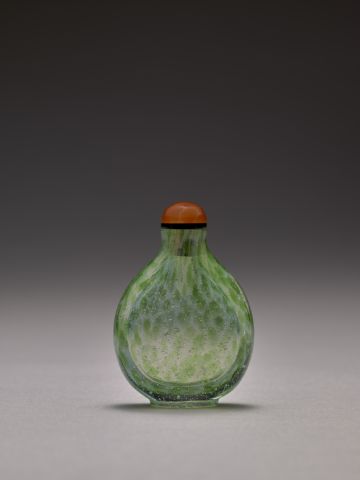
Bottle ID: 762
TRANSLUCENT GREEN WITH BUBBLES
Date: 1730-1840
Height: 45 mm
Glass, of flattened circular form with shoulders sloping to a cylindrical neck with slightly everted mouth and with a neatly carved oval foot, the bubbly glass with green splashes sandwiched between translucent milky-white and transparent glass layers.
Attributed to Beijing.
Similar Examples:
Crane Collection no. 367
Provenance:
Bonhams New York, September 9, 2019, lot 134
A New York Private Collection
Alice B. McReynolds Collection, no. 276A
Sotheby's Los Angeles, October 31, 1984, lot 19
Since the publication of the Palace Archives in both Chinese and English, the knowledge that is at the fingertips of today's researchers has grown enormously in terms of the activities of the Imperial Workshops and their output. By deduction, the Archives also give clues to what was happening outside the Palace. However, it is still not clear when Beijing's commercial glass production began. Given that Beijing was the capital of the last three dynasties and that glass production was a centralized process, it is likely that it commenced relatively early and from the seventeenth century onwards, Beijing became the center of glass-making in China. Boshan in Shandong Province was another center, known early on as "glass city". Glass crafted in Beijing was termed liao qi meaning objects fashioned from glass made in Shandong where Boshan is situated, while the words guan liao referred to glass from the Imperial workshops or "official glass". Liao qi was the name given by the glass-makers of Boshan to glass that was subsequently used in Beijing and being transported into the area as ingots or blocks, which were then melted down and re-worked to make the finished product. During the reign of Qianlong, when large amounts of glass objects began to appear at Court and in the homes of the wealthy, there was keen competition between three studios in Beijing for the production of glass objects including snuff bottles - the Xin family, the Le family and the Yuan family. Unfortunately, it is not known which families made which snuff bottles. A bottle such as this one would have been manufactured as part of the commercial production, rather than from within the Palace. Despite its contemporary look, it is likely to be eighteenth century and illustrates clearly what the glass makers of the time could produce and the fact that this bottle survives to this day is a testament to the proficiency of the artisans.
< Back to full list

 English
English 中文
中文